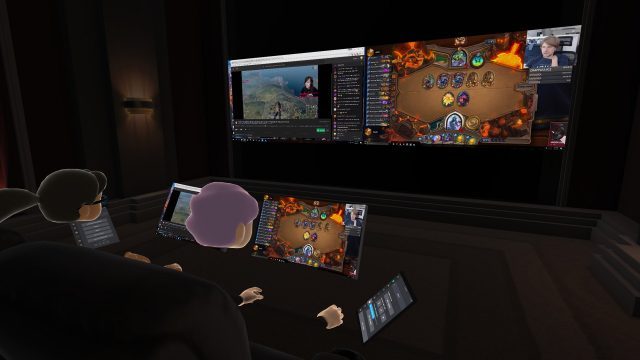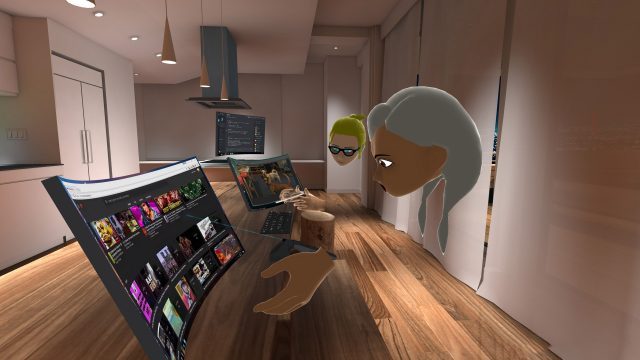Bigscreen is a social VR app which lets VR users bring their PC desktops into virtual reality, as if sitting at their computer next to friends or co-workers. Users inside of Bigscreen can see each other’s desktops which means you can watch movies or play games together. With Bigscreen still in beta, the streaming functionality has been hit or miss, but a new update promises to bring “flawless” 1080p streaming at 30 FPS to everyone.
Update (7/25/17): We got a chance to try out Bigscreen’s promised 1080p 30 FPS video streaming. While we can’t profess to have run any type of reliable metric to see empirically if it was working as advertised, visually there was little discernible difference between locally played 1080p 30FPS content (i.e. the verifiable target fidelity) and content streamed between two people. Whether it was watching two other people stream video contemporaneously in split-screen mode on the 100-foot cinema screen, or sharing smaller personal screens while sitting next to each other—it seemed to conform to the level of visual fidelity we expected. That said, minor hiccups did occur once or twice during initial video buffering where locally displayed video was superior to streamed video including a few dropped frames that we estimate dipped into 15-20 FPS territory, but over the course of testing several videos we saw these issues as few and far between. We were also told that there are still outstanding issues regarding global desktop audio, but we didn’t encounter anything during our demo—both with and without the Bigscreen staff—that would suggest anything showstopping. Tests were conducted with users chatting between California and Europe. The patch will be available today for Rift through the Oculus Store and HTC Vive and Rift through Steam.
Update (7/15/17): Bigscreen has confirmed the new update will launch for everyone on July 25th and has teased the update with a new GIF:
For those interested in helping to test the update ahead of the launch, Bigscreen invites you to join the Bigscreen Community chat server on Discord and join the private alpha test. The original article continues below.
Original Article (7/7/17): Your computer can do a million things—browse the web, watch YouTube, edit movies, create documents, send email, play games, and on and on—what if you could just bring your PC into virtual reality and join up with friends? Then you’d be in a room with your friends and their PCs, which can also do a million things. That’s the surprisingly simple idea that makes Bigscreen magical.
 But, making it happen relies on being able to stream desktops between each user with solid performance. For many users using Bigscreen’s multiplayer mode, streaming screens has been sub-par, making desirable social activities like watching Netflix or playing games with friends impossible due to choppy framerates which could often look more like slideshows than moving video.
But, making it happen relies on being able to stream desktops between each user with solid performance. For many users using Bigscreen’s multiplayer mode, streaming screens has been sub-par, making desirable social activities like watching Netflix or playing games with friends impossible due to choppy framerates which could often look more like slideshows than moving video.
That’s all about to change, says Bigscreen founder Darshan Shankar. He and his team have been working on a major overhaul of the app’s streaming tech and a new version will bring smooth, high quality desktop streaming to all users. Shankar explains:
We’ve spent the past year rewriting our media engine and networking stack from scratch. Our new technology takes advantage of Nvidia and AMD graphics cards for hardware accelerated encoding and decoding, enabling flawless 1080p30 streaming for all Bigscreen Multiplayer users. Previously, Bigscreen multiplayer would perform poorly for some users and consume 80-100% of CPU. Our new tech doesn’t use the CPU or GPU resources that games use, and instead uses the dedicated video acceleration chips on the graphics cards. It’s a massive increase in performance and functionality.
The performance enhancements brought by the new streaming tech will do more than just make your friend’s screen smooth, it will also open the door to raising the current limitation of four users per room. Shankar says that another update following the streaming overhaul (in the next one or two months) will enable rooms supporting somewhere between 6 to 10 users at a time, and maybe even more down the road.

Bigscreen users who use the app in single player as a VR desktop environment also have something to look forward to: optimizations from the overhaul can “reduce CPU usage by 50% and reduce GPU usage in some environments by 60%,” Shankar says.
The update will also come with expanded support for Windows 7 and laptops with Nvidia Optimus graphics, and will bring with it an IMAX-sized cinema environment with “real-time lighting and a new artificial intelligence NPC system.”
For those wanting to love Bigscreen, but struggling to do so because of streaming problems, the forthcoming update could be a defining moment. Shankar says the new version is in private alpha presently and is due out “in a couple weeks.”






